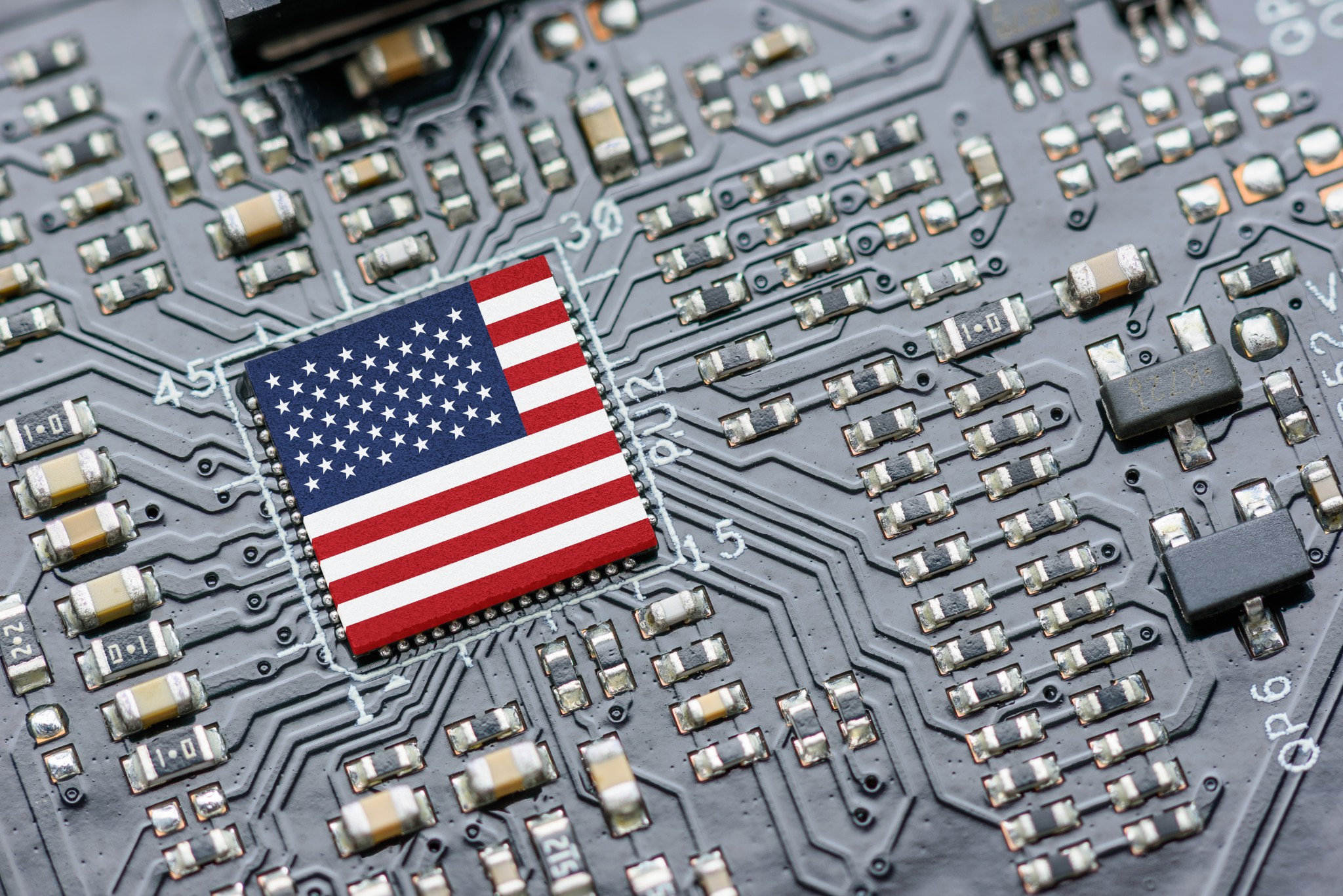The world’s technological web is being rewoven. Two heavy knots—America and China—are loosening their ties. Call it de-risking, decoupling, or (better) the great unknotting. Either way, it is real, it is accelerating, and it can—done prudently—restore U.S. strategic autonomy, rebuild productive capacity, and re-anchor prosperity in the American heartland.
I. From Chimerica to Choice
For two decades, “Chimerica” stuffed American shelves and hollowed out American fabs. That trajectory bent—first abruptly in 2018–19 as the United States used Section 301 tariffs to confront systematic mercantilism and IP theft,[1] then more comprehensively with targeted controls on advanced semiconductors and tools beginning October 7, 2022.[2] Those BIS rules, refined since, established a “small yard, high fence” around truly foundational technology—chips, advanced computing, and the equipment that makes them.[3] The intent is narrow but necessary: protect decisive chokepoints without severing benign commerce.
Critics say “decoupling” is fuzzy, but the analytic baseline is clear. Carnegie’s Jon Bateman—whose work has shaped this debate—describes the process as a partial, iterative reduction of tech interdependence driven primarily by U.S. policy where national security and economic resilience overlap.[4] That is exactly what’s happening.
II. The Evidence: Trade, Tariffs, and the Tilt in Supply Chains
Look at the facts—not the slogans.
- China’s share of U.S. goods imports has fallen to multidecade lows. By 2024, China accounted for ~13.4% of U.S. imports, down from ~22% in 2018; Mexico overtook China as America’s top source of goods in 2023 and extended its lead in 2024.[5]
- New tariff rounds have deepened the shift. Following USTR’s 2024 four-year review, the United States finalized higher Section 301 rates across targeted product lines (EVs, batteries, solar, critical minerals). In 2025, containerized imports from China fell sharply year-over-year after tariff hikes—while Southeast Asian and North American share rose. This is diversification, not isolation.[6]
- Manufacturing is rebuilding at home. U.S. factory construction—a forward indicator of productive capacity—has surged to historic highs since 2022 and remained elevated through 2025 (measured by Census “manufacturing structures” outlays tracked by FRED). That boom reflects semiconductors, batteries, clean-tech, and advanced logistics—industries that matter for power projection and wages.[7]
- Capital is reallocating. The BEA’s 2024 outward investment data show U.S. multinationals tilting away from China while scaling investment in allied manufacturing hubs—consistent with “ally-shoring.”[8]
These are not theoretical models; they are market responses to new policy guardrails. And yes, Trump lit the fuse—reasserting tariff leverage, elevating CFIUS and outbound screening as strategic tools, and moving China from business-as-usual to business-if-safe. The current framework—CHIPS/IRA carrots plus focused controls—builds on that foundation. That continuity is a feature, not a bug, of a serious national strategy.
III. The Small Yard: Why the Fence Must Be High
Semiconductors, advanced compute, EDA software, and leading-edge tools are not merely “sectors.” They are the substrate of military power, dual-use AI, secure communications, and modern industry. Once an adversary locks in an advantage at these choke points, latecomers pay compounding costs. That’s why the yard must be small but the fence high: allow routine trade; deny the handful of capabilities that—if transferred—would underwrite surveillance states, precision strike complexes, and coercive leverage over allied economies.[9]
A common retort is that controls “force China to innovate.” Perhaps—but innovation at the frontier is path-dependent, capital-hungry, and time-sensitive. Keeping leading-edge tools and compute on Team America buys the very commodity strategy needs: time—time to onshore fabs, stand up allied capacity (NL/JP/KR/TW), secure lithography supply chains, and train a bigger domestic talent pipeline.
IV. Costs, Benefits, and the American Way to Mitigate
Serious people quantify trade-offs. The IMF’s fragmentation studies bracket long-run global GDP losses from 0.2% in mild scenarios up to ~7% in extreme, two-bloc worlds.[10] That range is wide—and policy choices determine where we land. The goal of a pro-growth, pro-freedom decoupling is simple: keep the world closer to the low-cost edge by targeting only what we must and backfilling with investment at home and with allies.
That is why industrial policy must be offensive, not only defensive. Grants and tax credits are not corporate welfare when they solve genuine public-goods problems—aggregate risk, coordination failure, and learning curves. The historical parallel is not central planning; it is Hamilton’s and Lincoln’s American System: tariffs for infant industries, internal improvements, a sound credit architecture—nation-building economics for a free people.[11]
V. TikTok, Data Sovereignty, and the Cultural Front
Economic power and cultural influence interact. The ongoing forced divestiture and Americanization of TikTok’s U.S. operations—with algorithm oversight, U.S. data localization, and Chinese control reduced below de minimis thresholds—signals a broader principle: adversary-controlled apps that shape our information sphere will not be allowed to arbitrate our public square.[12] The details are evolving, but the direction is unambiguous: data sovereignty is a legitimate national interest in the AI age.
VI. A Pro-Trump, Pro-U.S. Doctrine for the Next Decade
Here is the clear, coherent path that marries strategic realism to American dynamism:
- Narrow the yard; heighten the fence. Keep the list of controlled technologies compact, refresh it regularly, and enforce it ruthlessly—multilaterally where possible, unilaterally where necessary. (Oct. 7 rules are the model.)[13]
- Supercharge the build-out. Convert the factory construction surge into durable capacity: finalize CHIPS awards, accelerate permitting, waive bottleneck regulations for strategic plants, and codify “Buy Allied” carve-outs. (The FRED series shows the capex wave; now lock it in.)[14]
- Weaponize predictability. Publish a Decoupling Baseline: a stable, five-year schedule of tariff pathways and eligibility rules that encourages firms to re-site once—not three times. Use tariff preferences to reward Mexico, Canada, Taiwan, Korea, Japan, and trusted Southeast Asian partners.[15]
- Hard-ring data and apps. Require adversary-controlled platforms to divest, domicile, and submit source-code/algorithmic audits—or exit. Make “clean data” the new “most-favored nation.”[16]
- Talent without naïveté. Expand STEM visas from allied democracies; keep tight screening on military-civil fusion vectors; and expand domestic training—especially technician pipelines for fabs and power electronics. (This complements the “small yard” doctrine rather than contradicting it.)[17]
- Measure what matters. Track a short dashboard quarterly: (i) U.S./allied share of leading-edge wafer starts; (ii) mean time to fab commissioning; (iii) import concentration indices in batteries, magnets, and critical minerals; (iv) R&D intensity in power semis and tools; (v) exposure of U.S. cultural platforms to adversary control.
VII. The Payoff: Strategic Autonomy, Civic Confidence, Shared Prosperity
The payoff is not abstract. A nation that makes advanced chips, builds power trains, refines critical minerals with allies, and secures its infosphere is harder to coerce, faster to adapt, and fairer to its workers. The early signals—lower China import share, higher North American sourcing, factory-building at record levels—show that policy can bend the curve.[18] The task now is to finish what we started, with the clarity and confidence of a republic that believes in itself.
Endnotes
[1] Office of the United States Trade Representative, Section 301 Investigation of China’s Acts, Policies, and Practices Related to Technology Transfer, Intellectual Property, and Innovation (2018).
[2] Bureau of Industry and Security (BIS), Export Administration Regulations: Advanced Computing and Semiconductor Manufacturing Items (Oct. 7, 2022).
[3] White House National Security Advisor Jake Sullivan, “Remarks at the Special Competitive Studies Project Global Emerging Technology Summit” (Sept. 16, 2022).
[4] Jon Bateman, U.S.-China Technological Decoupling: A Strategy and Policy Framework (Carnegie Endowment for International Peace, 2022).
[5] Federal Reserve Bank of Dallas, “Mexico Surpasses China as Top U.S. Trade Partner” (2024).
[6] USTR, Four-Year Review of Section 301 Tariffs (2024); Reuters, “U.S. Imports from China Slide in 2025 after Tariff Hikes” (2025).
[7] U.S. Census Bureau, Value of Construction Put in Place Survey: Manufacturing Structures (2022–2025), via FRED.
[8] Bureau of Economic Analysis, Direct Investment by Country and Industry (2024).
[9] White House, National Security Strategy (2022).
[10] International Monetary Fund, Geoeconomic Fragmentation and the Future of Multilateralism (World Economic Outlook, Apr. 2023).
[11] Alexander Hamilton, Report on Manufactures (1791); Abraham Lincoln, “Annual Message to Congress” (Dec. 1861).
[12] Financial Times, “U.S. Pushes TikTok Divestiture Deal” (2024); Reuters, “White House Finalizes TikTok Divest-or-Ban Framework” (2025).
[13] BIS, Export Administration Regulations: Advanced Computing and Semiconductor Manufacturing Items (2022).
[14] U.S. Census Bureau/FRED, Manufacturing Structures (2022–2025).
[15] Dallas Fed, “Mexico Surpasses China as Top U.S. Trade Partner” (2024).
[16] Reuters, “U.S. Advances TikTok Divestiture” (2025).
[17] White House, CHIPS and Science Act Implementation Strategy (2023).
[18] Supply Chain 24/7, “China’s Declining Share in U.S. Imports and the Rise of Nearshoring” (2024).
The views expressed in this article are the author’s own. They do not necessarily reflect the editorial policy of the South Asia Times.







